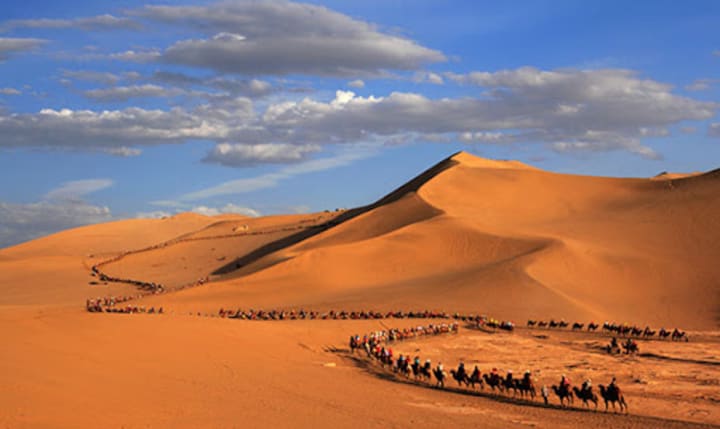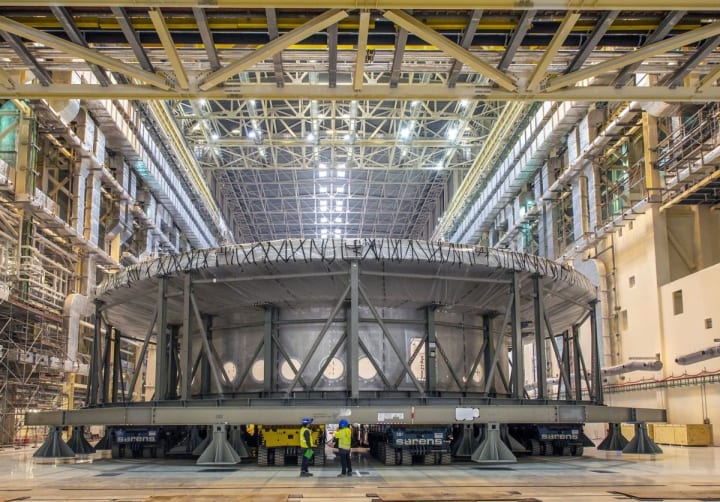Worldwide, massive construction projects are in progress.
You might have visualized a glittering city with spectacular architecture and cutting-edge technology if you wanted to picture the future. Even if it appears like something from a science fiction movie, long-term construction projects all around the world are actually experiencing some of it.

If you want to imagine the future, you may have daydreamed about a gleaming metropolis with incredible architecture and cutting-edge technology. The stuff of science fiction films, but part of this is already occurring in long-term construction projects around the world that aim to turn arid nations green. Transport passengers by rail at speeds of over 500 km/h, build entire cities from scratch, use nuclear fusion to produce energy, or send some of us into space. What are these large-scale projects, and where are they being constructed? We are a world of megaprojects; keep reading.
Dubailand

Modern-day Dubai is the king of massive development projects, from the imposing Burj Khalifa to the man-made islands. Dubailand, a 64 billion project with a 278 square kilometer almost absurd scale, takes things even further and is expected to be finished in 2025. The enormous proposal, which has undergone numerous changes over the years, will eventually house a theme park and the largest hotel in the world (6500 rooms). The project, which began in 2003 and had to be put on hold for five years in 2008, was to build a sports center, a sizable shopping mall, health facilities, and sporting arenas right in the middle of the desert.
The global village, which highlights 90 different cultures, a cricket stadium with a capacity of 25,000, an Ernie ells-designed golf course, and an artificial desert beach and water resort are just a few of the areas that are currently open despite the global recession.
Chuo Shinkansen

Japan, East Asia is a major market for high-speed trains, and Japan's Chua shinkansen, which uses a maglev-style train, is expected to enable a run of 286 kilometers in only 40 minutes. Unbelievable high-speed infrastructure. In its initial phase, the mostly underground network will run from Tokyo to Nagoya and then on to Osaka. The Tokyo Nagoya section of the line is scheduled to open in 2027, and once it does, trains will be able to reach speeds of up to 505 kilometers per hour, slashing the current travel time between the two cities by a full 50. The 52 billion idea was first conceived back in the 1990s.
This will undoubtedly be quite the experience, taking passengers on a regular ticketed trip at a speed of more than 40% of the land speed record.
Lusail City

As the first city in Qatar, Lusail City is a planned concept city with aspirational aspirations. Real estate in areas where foreigners are permitted to buy it has been in high demand, with a strong focus on cutting-edge infrastructure and opulent living in a region that is expanding quickly. It will be 16 kilometers from the city "of Doha" and will consist of four upscale island communities with a final goal population of about 450,000.
The city was only conceived in 2005, but it already has distinctive tower blocks, luxurious spa locations, a marina, a Venetian-themed island, and an 80,000-seat stadium that is one of the planned venues for the 2022 Fifa world cup. There is also a tonne of ongoing construction work. It is part of Doha's plan to diversify from a dependence on oil income and account for a growing international population.
South-North Water Transfer Project

China has a serious issue with water distribution; in fact, although having about 50% of the population, the north only possesses 20% of the nation's water resources. This issue is not generally known in the West. The strategy China will use to deal with these three enormous canals. One of the most expensive construction projects in human history, the 48-year construction plan has already cost 79 billion dollars.
In the end, it will channel 44.8 billion cubic meters of water from the Yangtze River and its tributaries through one of three canals, each of which will travel more than 600 miles. This project, which was first discussed in 1952, will have an impact on a variety of areas, from the location of an industry that must be kept away from the canals to the need to relocate 3,30,000 people to the construction of pumps to move the water as intended down each route. The entire endeavor is enormous in scope and, perhaps predictably, extremely divisive.
The New Silk Road

The Silk Road was formerly the trade route between China and Eurasia. a vital trade route that connected cultures through commerce two whole millennia ago. The Belt and Road Initiative is a policy centered on this that China feels can be as vital to trade. In 2017, the communist party constitutions were amended to reflect this.
Large-scale strategic infrastructure investment is the key; by 2027, spending on the project's many components is projected to total 1.3 trillion dollars, with new construction including highways and power plants. Opposition comes from many neighbors, including India and South Korea, in part because some people perceive China's investment as an effort to assert political influence globally, but also because of the environmental effects. Pakistan rail developments in Indonesia, and ultimately 1,600 contentious core power plants with 60 countries in total involved.
The World Bank, though, acknowledges the potential for the large infrastructure project to boost the global economy by modernizing a number of corridors to stimulate it, but it also has worries about its long-term viability.
The Iter

A large-scale international energy project is the ITER. A Tokamak is a device intended to demonstrate the viability of large-scale nuclear fusion as an energy source, why it is carbon-free, and should it succeed, has the potential to create an essentially damage-free energy resource that could be replicated across the globe. It is being built in "the South of France" by 35 different countries. The goal of the 35-year effort is to demonstrate sustained fusion's viability as an energy source.
China, the European Union, India, Japan, Korea, Russia, and the United States are among the countries contributing money to build what will be the largest and most promising Tokamak. The Tokamak itself is an experimental device designed to harness the energy created by fusion inside a Tokamak. The energy is absorbed as heat in the walls of the vessel and can then be converted into power.
Guangzhou Football Stadium

Chinese football has advanced quickly in recent years and now resembles Major League Soccer in some ways; in the past, it was viewed as a highly compensated retirement community for the sport's top teams. Guangzhou Football Club of the Chinese Super League will soon have a stadium that will be the envy of the sports world.
The Lotus Crown-inspired stadium, whose construction cost 1.7 billion dollars, got underway in April 2020. It will have a shopping center and leisure elements, but at 100,000 incapacities, a nod to the city's fame for flowers as well as the pitch itself. Additionally, it will be among the largest stadiums in the world. The enormous ultra-modern structure will be lit up in technicolor to make the area come to life. The entire project is scheduled to be completed in December 2022, focusing on the red of the home team.
Great Man-Made River Project

Libya is a country in North Africa's arid region. has been constructing its "Great Man-Made River Project" to irrigate a sizable portion of the nation's territory since 1985, and it is anticipated that it will continue to do so through the year 2030. The GMR is designed to provide clean water to a significant portion of the nation and boost its agricultural industry.
It's so important, in fact, that it was once said to turn the desert nation as green as a flag. The project, which at the time of the comment was simply all green, is a collection of pumps and underground pipes that bring water from aquatic planes deep beneath the ground of the Sahara desert. Difficult but far superior to desalination of the Mediterranean, which was the main alternative progress, the project has already been delayed by NATO bombings after claims in 2011 that a building making pipes were a storage facility for weapons.
Al Maktoum International Airport

Al-Maktoum International Airport in Dubai is already a significant transportation center. However, the congested area is currently expanding to a colossal 21 square miles, which is planned to concurrently accommodate 200 wide-bodied aircraft. Al-Maktoum has greater potential for expansion than the main Dubai international airport, however, it will take some time. The 32 billion dollar addition to the already super-sized hub will allow 220 million people to travel through. This project's many phases will last until 2050. Al- Maktoum will become a global leader thanks to its six new railway tracks, new runways, new terminal biometric systems, seven train stations, and 55 border control checkpoints.
International Space Station

A never-ending work in progress. Every 92 minutes, the international space station, a project of 15 nations, completes one orbit of the planet. The small matter of being in orbit, however, greatly raises construction expenses. The ISS is presently receiving 60 million dollars worth of upgrades, including new solar panels, upgraded living quarters, and other station upgrades that could eventually transform it into a for-profit low-earth orbit platform.
There are other initiatives from California, China, India, and Russia that aim to increase humankind's permanent presence in space. The space station itself is currently around the size of two football fields. If the long-term goals are achieved, thousands or maybe a million people may eventually settle into Orbit.
Do you believe that humanity is sufficiently ambitious in its key long-term projects?
Last but not least, historical megaprojects like the Great Wall of China or the Pyramids of Giza in Egypt served as enduring examples of human achievement simply because so much labor was put into them. However, the project's scope, budget, and relevancy are now much more crucial.
I'm amazed at how many construction projects are under progress in every major city as I traverse the world. If we simply look at the front pages of newspapers, it would seem that the majority of megaprojects are happening in China and Dubai, yet there are hundreds more that have gotten much less attention.
We will start the shift to megacity cultures, lifestyles, and economies during the ensuing decades. The importance of megacities will surpass that of the nations in which they are located. Any failures will have wide-ranging consequences because investment in megaprojects has reached previously unheard-of levels.
Thanks...
About the Creator
Ahamed Thousif
🌟 Welcome to the realm of exploration, where communities come alive through the power of words! 📚✨ Join me as we embark on a journey to discover the vibrant tapestry of stories and Poems.
VISIT - "MY FOOD BLOG"






Comments
There are no comments for this story
Be the first to respond and start the conversation.